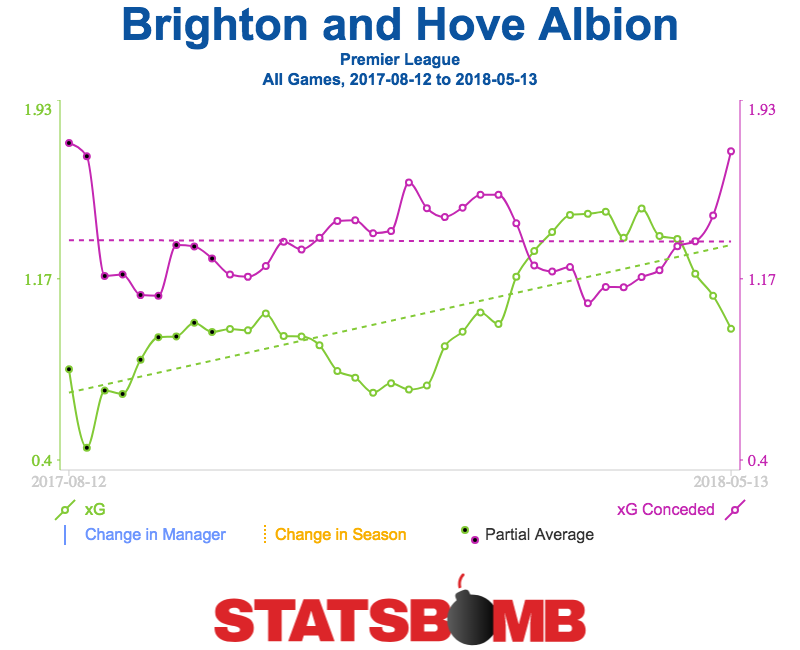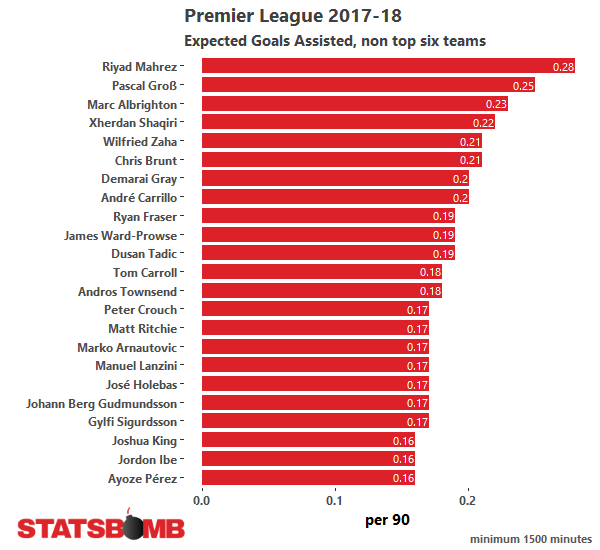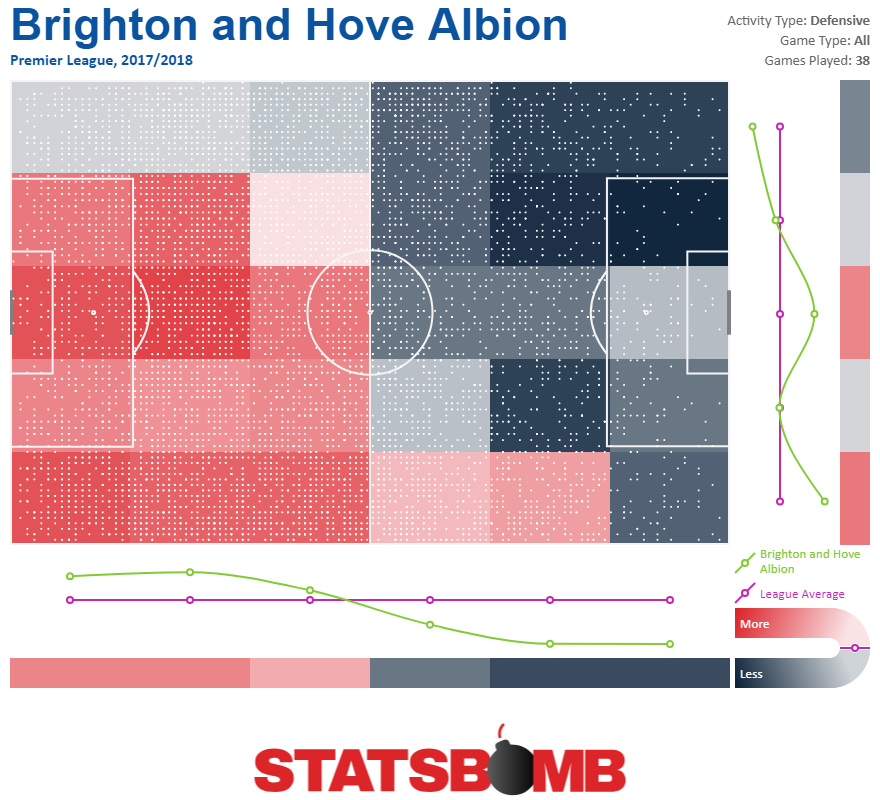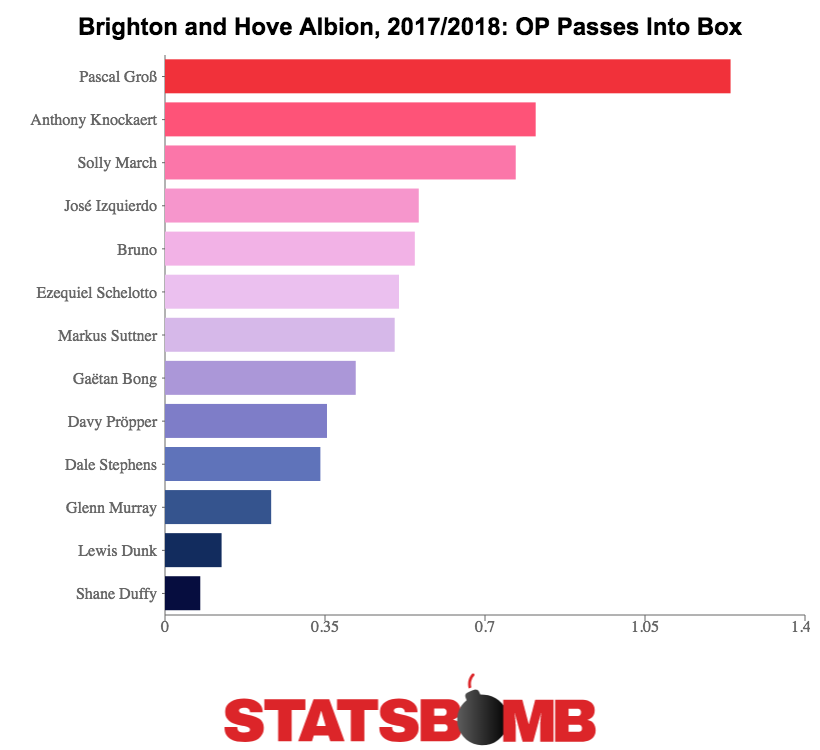So far, so good?
Brighton and Hove Albion’s first season of top flight football since the early 1980s went about as planned, hitting the mythical 40 point mark exactly and sitting fairly comfortably in fifteenth. The side followed the fairly well worn path for a newly promoted team of never being entirely out of the relegation fight, but never appearing hugely likely to go down either. They backed those results up with fairly agreeable numbers too. They had a respectable expected goal difference which ranked them as the thirteenth best side in the division. The defence was fairly stable in “better than relegation” territory throughout the season, while the attack gradually improved before a brutal run in when the side faced all of the top four in the space of the last five games which brought things down to Earth (as such, the dip at the end of the season should not ring too many alarms).

In terms of how they go about doing it, Brighton are best described as doing the basics really well. They play a compact 4-4-1-1 that often looked more like a 4-4-2 without the ball. They ran out a very consistent eleven, ranking as one of the sides that rotated the least across the season. On the attacking side, Glenn Murray did a serviceable job leading the line, though his widely praised goalscoring pursuits drop down to a less impressive 8 for the season when you strip out the penalties. José Izquierdo was a crucial outlet from left midfield, often making valuable runs without the ball that didn’t contribute much to goals and assists but helped the side get up the pitch. The keystone, though, was clearly Pascal Gross. Playing nominally as a number ten but often drifting into wide areas in possession, he was the most important creative force both from set pieces and open play, with his 8.97 expected goals assisted being nearly a third of Brighton’s total assisted xG. This compared favourably to the rest of the league, with only Riyad Mahrez putting up better xG assisted per 90 for a club outside the top six.

Gross was also arguably Brighton’s key player out of possession. Despite being more of an attacking midfielder by trade, his role in this system often asked him to push up alongside Glenn Murray as an additional striker without the ball, and it was the German who was the key pressing trigger in the side. Though they played a fairly conventional British style deep block system, it was this defensive work from the front primarily from Gross that often ensured that the defenders were not exposed.

No team in the Premier League defended deeper, with Brighton’s defensive actions coming 38.7 metres away from their own goal. They were certainly aggressive in these deep areas, though, being truly all action in their own half, as we can see with the amount of red on the left side of the defensive activity map.

A lot was made of how comfortable the centre back pairing of Lewis Dunk and Shane Duffy looked, and this was certainly true, though they benefited from the side’s compact shape at almost all times. That 37 year old Bruno was able to play regularly at right back without being embarrassed by some of the faster wide players in the league is a testament to this compact shape. There was an obvious trade off in attack, with central midfield pairing Dale Stephens and Davy Propper offering very little by way of forward emphasis. The pair combined couldn’t average even a single open play pass into the box per 90, leaving Gross to do most of the creative work himself. This lack of ball progression in central areas led to the team taking an awful lot of shots from outside the box, though for a promoted side with an emphasis on a compact shape this is perhaps more forgivable than it would be for “better” teams.

With the possible exception of Liverpool, no team in the Premier League has more visibly embraced analytics in the transfer market than Brighton. First among these would be Florin Andone from Deportivo La Coruña, and he very much fits the mould. There perhaps isn’t a more obvious move from a statistical standpoint than to sign a striker who significantly undershot his xG, having scored barely over half as many as one would expect him to last season, with a very strong xG per 90 of over half a goal a game, as well as a solid finishing record in previous years. It seems likely that he should be able to match the performances of the ageing Glenn Murray at least, with a potential upside of a much higher level that would see his value rise to several times the £5.4m Brighton paid for him. It’s hard to find anything of fault in this deal.
The £17.1m purchase of Alireza Jahanbakhsh from AZ Alkmaar was another who drew a lot of attention. Jahanbakhsh has been covered in great detail by Mohamed Mohamed for StatsBomb. I’d recommend reading the full article, but if you just want a flavour of what he can offer, here’s a snippet:
“There are things to like about what Jahanbakhsh could bring to the table for teams looking for wide players: dynamic passing skills, fludity with his dribbling to create shots for himself or others, but there are flaws to Jahanbakhsh’s game. Because of the heavy usage that he was entrusted with, his shot selection definitely emphasized quantity over quality… Despite the obvious grace that he has when at full bloom and the coordination he has on the ball, it’s still hard to call him an elite athlete, and that might be an issue against higher level competition if he does make a post World Cup summer move. It’s always difficult to tell exactly how much of his impressive numbers, should be chalked up to the massive talent disparity that exists in Holland between the top and bottom clubs along with the defensive frailties in the league.”
That his 21 goals last season came in the famously easy to score in Eredivisie makes it unlikely that he will replicate this in the Premier League, but he does have enough of a wide range of skills to suggest he can still be valuable. As Mohamed mentioned, his creative passing and chance creation is very good, which has generally been a more transferable skill from the Netherlands than goalscoring. Considering how much Brighton relied on Gross last season for creativity, Jahanbakhsh should diversify their options in this regard and help share the workload. At age 24, they’re getting him as he comes into his peak years and there’s the potential for a higher upside, but he should at least be a solid contributor.
Yves Bissouma is also an eye catching signing. The 21 year old central midfielder has arrived from Lille for £15.2m having so far only played one season of regular first team football in Ligue 1. In this time in France, Bissouma managed an impressive 5.7 tackles and interceptions per 90 combined with 2.2 dribbles per 90. Playing as a central midfielder, dribbling tends to be a more difficult skill than in the less congested wide areas, so this suggests he can offer much in terms of ball progression. The respected opinion of StatsBomb’s Mohamed sees him as someone who is “able to undergo defensive actions in different areas of the pitch, and immediately help the team transition the ball whether it be with his own dribbling or one of his teammates collect the ball”. Considering how little Brighton’s central midfielders were able to progress the ball last season, Bissouma should be able to offer more in this regard while still contributing defensively, though he may require a period of adaptation. At his young age, it also seems likely that he’ll see a performance boost at some point, so it’s another deal that looks wise on paper.
Elsewhere, left back Bernardo from RB Leipzig looks capable of replacing the ancient Bruno while offering additional depth at right back. Leon Balogun on a free transfer should give them more cover at centre back in an obviously low cost move. There’s really no way of knowing how Percy Tau might adapt from the South African Premier League, but at a £2.88m transfer fee and presumably low wages it seems a fair punt if the recruitment people think there’s something there. Really, all of this seems like a switched on recruitment process, looking in the right places for value players with potentially high upsides. There is a gradual improvement in the transfer work done by clubs, but in a league where teams still pay a huge premium for “Premier League proven” English players, it’s hard to fault Brighton for looking at more obscure leagues.
All this has taken place without losing any important players from last year. With the summer business in mind, it certainly feels like Brighton are in a stronger place now than twelve months ago. Within the club, survival will presumably be the target, and achieving that will generally be seen as a success to the outside world. With the recruitment that has been done to supplant the already solid foundations, though, one can be optimistic that more is possible. A midtable finish is not out of the realm of possibility this season, and this feels like a football club that could even build on that in the next few years.
Thank you for reading. More information about StatsBomb, and the rest of our season previews can be found here.